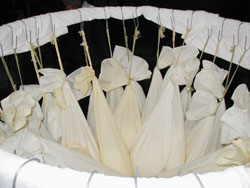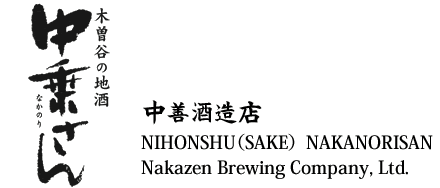
木曽川沿いの山側、かつては御嶽信者行列で賑わいをみせた旧御嶽街道に面したところに私どもの酒蔵があります。入口には大きな手造りの酒林(杉玉)が掲げてあり、初めて見た人は大きな蜂の巣!と間違えることもあります。

入口を入りますと、まず歴史を感じる黒い柱。約150年前に建てられた酒蔵ならではのおもむきです。

そんな店頭にはゆっくりと腰をすえ試飲を楽しめる長椅子があり、くつろいでお酒を堪能することができます。

そこを通りぬけ酒蔵に近づきますと、日本酒独特の香りがほんのり漂ってきます。いよいよ酒蔵見学の始まりです。
1. 仕込み水 水槽に貯水してあるのが仕込み水です。
Water Used for Brewing
昔から酒蔵は、水の良い土地にできました。しかし、近年は環境悪化のため良い水の 確保に苦労する蔵がたくさんあります。そんな中、中善酒造店では水源のままの水を 一切の濾過をせず使用しています。仕込み水は、良質な木曽御嶽山系の天然水です。

木曽御嶽山系の伏流水です。
お店の入口、旧御嶽街道を挟んだ山側に鍵のかかった小さな木戸があります。
その中はなんと30mもある真っ暗な洞窟です。だんだんと狭くなっていて、大人が屈んでやっと 入れる大きさです。その洞窟の一番奥から御嶽山系の天然水が豊富に湧き出ています。 その水を酒蔵までひいて仕込み水として使用しています。
水質はやや軟水で、旨味もありながらすっきりとしています。 どうぞお飲み下さい!
The water stored in this tank is used for brewing the nihonshu. In the old days, nihonshu was brewed in areas that had access to clean, fresh water. However, with an increase of problems affecting the environment, many breweries are struggling to gain access to fresh water. Despite such difficult conditions in Japan these days, the Nakazen brewery sources its water locally from Mt. Ontake spring water – pure water that requires no distillation.
Between the entrance of the shop and the old Mt. Ontake road lies a small locked wooden passageway. Behind it lies a 30 meter long pitch-black cave. The passage increasingly shrinks to the point that an adult would need to crouch on their knees to pass through. At the very end of the tunnel sits the Ontake Spring source well from which fresh water bubbles forth. The water from this well is carried to the brewery to be used in making Nakanori-san Nihonshu.
The water itself contains very few minerals and has a rich but clean and refreshing taste.
2. 洗米・浸漬(しんせき)タンク
Washing and Soaking

お米を浸漬するタンクです。
洗米と浸漬の作業を行う場所です。
洗米は、精米したお米の表層についている糠(ぬか)を、冷水で洗い落とす作業です。最近は機械洗いが主流ですが、米の約半分まで精米した吟醸等の洗米は、赤ちゃんの肌を洗 うようにゆっくりと柔らかく手洗いをします。 浸漬は、お米を水に漬ける作業です。
浸漬では、米粒の中心まで水を十分に吸収させることが求められます。浸漬時間は米の種類、白米の水分、精米歩合、水温等によって変わりますが、 高精白になるほど吸水力が高くなるので、ストップウォッチで計測しながら 短時間で行わなければなりません。
Here we wash and soak the rice that will be used in brewing. First is washing. We use cold water to wash off the nuka (new-kah, or the fine powder left over from polishing) from the surface of the rice.
Each type of nihonshu requires different levels of polishing. With the ginjoh (geen-joh), or high quality brews, the rice has been polished down about halfway. The recent trend in nihonshu brewing has been to use machines to wash the rice. However, here at the Nakazen Brewery we wash all of the rice for our ginjoh brews by hand. We handle the rice as gently as we would a baby’s skin.
Next is soaking. In this process we make sure that the water has permeated each grain of rice all the way to the center of the grain. The time it takes to soak through depends on the type of rice, its moisture content, the level of polishing, and the temperature of the water. The higher the ratio the polish is, the more quickly it absorbs the water. Since the higher-end polished rice takes such a short time, we have to measure the soaking period with a stopwatch.
3. 甑(こしき)
Koshiki

お米を蒸す「こしき」です。
これはお米を蒸す釜です。この大きな釜は「こしき」といい約1tのお米が入ります。
食べるお米は炊飯ジャーに水といっしょに入れてスイッチオン、ですが、 お酒造りの米は「甑(こしき)」入れて蒸します。なぜ蒸すかというと、 米のでんぷんは蒸すことにより、麹(こうじ)の作用が受けやすくなるからです。 蒸さない米では麹のパワーを受けることができません。 蒸し時間は約1時間です。米の内側を軟らかく、外側を硬く蒸しあげるのがコツです。
This large pot, called a koshiki (koh-she-key) is used to steam the rice. We fill the koshiki with about one ton of rice. Normally, with the rice we eat, we put it in the rice cooker, add water, and turn the switch on, but with nihonshu brewing we steam the rice in the koshiki*. Steaming the rice makes it easier for the koji (koh-gee; the microorganism used in nihonshu brewing) to culture on the rice. Rice that isn’t steamed lacks the ability to properly culture koji and lacks the punch that it brings to the brewing process.
We steam the rice for about one hour. Our technique is to have the rice grains be hard on the outside but soft on the inside.
*A Japanese rice cooker does not fully steam rice but rather cooks it through a mixture of boiling and steaming.

こちらの重くて厚い扉の向こうが土蔵の酒蔵です。
4. タンク
The Fermentation Tanks

琺瑯(ほうろう)塗りのタンクです。
かつては木の桶がつかわれていましたが、昭和初期に琺瑯(ほうろう) 塗りのタンクが開発されて、現在ではほとんどの酒蔵が琺瑯タンクか ステンレスのタンクを使用しています。琺瑯(ほうろう)は、 木の桶に比べて維持管理や消毒が容易であるだけでなく、もろみに余計な木香がつきません。 このタンクに記されている数字は、一番上の数字がタンクの番号(名前)、二番目は容量(リッター数)、三番目がこのタンクの使用が許可された日です。
Our fermentation tanks are made of enamel cast iron. In the past, wooden casks were used, but at the start of the Showa Era (1926-1989) enamel tank technology was developed. Currently almost all nihonshu breweries use either enamel cast iron or stainless steel tanks. In contrast to the wooden casks, not only are enamel cast iron tanks easier to maintain and sanitize, but they do not leave an unnecessary wooden taste and aroma in the moromi (moh-roh-me, the rice before it is filtered into nihonshu).
There are three sets of numbers written on the tanks. The top number is the name of the tank. The second number is how many liters are stored in the tank. The third number is the date that it was licensed for use.
5. 麹室(こうじむろ)
Koji Culturing Room

麹室(こうじむろ)といい麹を造る部屋です。 麹室の中は、室温約30度・湿度60%という真夏のような暑さです。
昔から、酒造りの工程を「一 麹、二 酒母、三 造り」と言います。
まずは酒造りの難関であり重要な、二昼夜におよぶ麹造りからスタートします。 蒸した後、約35度まで冷ました蒸米を麹室に引き込み、 床いっぱいに広げ種麹をふりかけ、すばやく手もみをします。 そして、麹菌が均一に発育するように麹米の山を崩し、 手で混ぜ合わせる切り返しといわれる作業を行います。 その後、仲仕事、仕舞仕事等の作業工程を経て、出来あがった麹は 栗のような甘い香りです、真綿のような美しさは一見の価値があります。
麹米は、この部屋のむかいにある枯らし場に運ばれます。 こちらの枯らし場の室温は約15度です。麹米の温度を急激に下げて結露 させないようにすることと、麹米の余計な水分を飛ばすためにこの部屋で一日枯らします。
Koji (koh-jee) is the microorganism that makes the magic of nihonshu brewing, soy sauce making, and miso production possible. This microorganism is unique to Japan and East Asia and plays a pivotal role in Japanese food culture. Koji is cultivated by mixing a starter with steamed rice and maintaining it in a controlled environment.
We keep the koji culturing room at 30°C (86°F) and about 60% humidity, similar to a midsummer’s day.
Since the old days, the process to make nihonshu has followed three steps.
1. Koji production 2. Yeast starter production 3. Brewing
Nihonshu brewing begins with the difficult but all-important two-day process of making koji. First, we cool the steamed rice from the koshiki to a temperature of about 35°C (95°F) and then place it in the koji culturing room. We spread the rice on the floor and then cover it with the koji starter. We carefully massage the starter into the rice and then, to ensure even culturing, we mix and turn over the rice by hand – a process called kirikaeshi (key-ree-kai-she).
After this, we carry out a two-stage process of temperature control. The stages are called nakashigoto (nah-kah-she-go-toe) which takes 7-8 hours and shimaishigoto (she-my-she-go-toe) which takes 6-7 hours.
The finished koji has a silken beauty and carries a sweet chestnut aroma.

こちら階段をお上りください。酒母室があります。
6. 酒母室(しゅぼしつ)
The Nihonshu Yeast Starter Room

こちらの部屋が酒母室です。
「酒母」とは読んで字の通り酒の母、人間で言うとお母さんのおなかの中です。 そして、酵母は赤ちゃんです。
酵母は糖分をアルコールにする力を持つ微生物で、アルコールだけではなく、 あのすばらしい吟醸香や味の成分となる酸などの日本酒らしい香味をつく り出してくれるのです。空気中の雑菌に汚染されないように大切に育てます。 タンクに水と麹と酵母を入れ、水麹というものをつくります。 ここに冷ました蒸米を入れます。吟醸等の長いもので約二週間をかけて酒母が出来上がります。
先ほど上ってきた階段をもどり仕込み蔵へまいります。
This room is the yeast starter room. In Japanese it is called shubo (shoe-bow) with the characters 酒母 literally translating to the “nihonshu’s mother”.
Yeast is a microorganism that takes sugar and transforms it into alcohol. Along with alcohol, this yeast also produces acidity, giving the finished product the refined aroma and taste that define nihonshu.
We take great care in creating our starter and ensure that outside microorganisms do not enter the room.
We make mizukoji (me-zoo-koh-jee) by placing water, koji, and yeast into the tank. Here we add the steamed rice which we have cooled down in advance.
It can take us up to two weeks to produce a starter.
7. 仕込み蔵(しこみくら)
Nihonshu Fermentation Storehouse

仕込み蔵は、創業当時のままの土蔵造りです。見てくださいこの立派な梁!初代の中澤善吉が残してくれた大切な宝物です。
土蔵は外の気温が伝わりにくいため、夏は約15度と涼しく、 冬は約5度と酒を仕込む温度に適しています。 麹と酒母が出来上がると、いよいよ本格的にアルコール発酵させる仕込みです。
日本酒の仕込みは通常、タンクの中に酒母、麹米と掛け米(洗って蒸した米)、 仕込み水を入れますが、一度に全部入れるのではなく、4日かけ3回に分けて足していきます。 一日目を「添(そえ)」といい、タンクに1回目の酒母・仕込み水・麹米と掛け米を入れます。
二日目は「踊り」といって仕込みはお休みの日で、酵母の増殖を促します。
三日目を「仲(なか)」といい、大きなタンクに移し、2回目の仕込み水・麹米と掛け米を入れます。
四日目には仕込み水、麹米と掛け米の量を多くします。3回目は「留(とめ)」 といいます。この状態のものを「もろみ」といいます。

創業当時のままの梁です。
酵母の力でアルコール発酵が進むともろみの表面が泡で覆われます。泡はしだいに濃さを増して盛り上がってきます。 この泡の様子や香り、アルコール、糖分、酸度等のデータを見守りながら、 一本一本のタンクの発酵温度を微妙に調整するのです。
留仕込みから約30日後、香味のバランスが整った時点でしぼります。
This storehouse, made of mortar, has remained intact since the days it opened for brewing nihonshu. Just look at how magnificent this support beam is! This storehouse is a precious treasure that the first generation brewer Nakazawa Zenkichi passed down.
The mortar walls of the storehouse insulate the building, protecting it from drastic temperature changes brought in from the outside. In summer, the temperature is a brisk 15°C (59°F), and in winter 5°C (41°C): temperatures suitable for brewing nihonshu.
Once the koji and yeast starter have been prepared, it’s time to begin the actual process of alcohol fermentation.
The general process of brewing nihonshu involves placing the yeast starter, the koji-cultured rice, the steamed rice, and the brewing water into the tank. We add these in three phases over a four-day period instead of adding them all at once.
The first day is called soe (添 soh-eh – addition), where the first phase of yeast starter, brewing water, koji-cultured rice, and steamed rice – the base ingredients – are added to the tank.
The second day is called odori (踊り oh-dough-ree – the dance). This is a day of rest in the process. We want to allow the yeast starter to rise in the mixture.
The third day is called naka (仲 nah-kah – together). We first transfer the contents into the large tank. Then we add the second phase of the base ingredients into the mixture.
On the fourth day we greatly increase the volume of the base ingredients. This third phase of adding ingredients is called tome (留 toe-meh – the stop). At this stage of the fermentation process, the mixture is called moromi (moe-row-me). As the yeast continues to ferment the ingredients into alcohol, the surface of the moromi gets covered in a layer of foam. This layer will then gradually get thicker and rise. We keep careful track of the state of the foam and aroma, as well as the levels of alcohol, sugar, and acidity in each tank and make slight adjustments to the temperatures as necessary.
We press the moromi 30 days after the third phase of adding ingredients, the point at which the flavors have rounded out.
8. もろみ圧搾機
The Filter Press

お酒をしぼる機械です。
発酵が終わったもろみはにごり酒状態です。 もろみを圧搾機に入れ圧力をかけると、清酒と酒粕(さけかす)に分かれます。 しぼりたての原酒の香味をチェックする時は、我が子のような酒の誕生を待ちわびた 造り手の緊張する一瞬です。板と板の間に張りついたものが冬場に出まわる板粕です。 板粕はそのまま焼いて食べてもおいしいですし、粕汁等にして食べてください。
冬場に出荷しなかった酒粕は酒粕熟成用タンクに貯蔵し、7月くらいまでほどよく 熟成させ練粕(夏粕)として出荷します。練粕はワサビ漬や奈良漬といった漬物用として使われます。

酒袋を使った袋しぼり
お酒によっては、もろみを酒袋に入れ自然の圧力で一滴一滴しぼる手間暇かけた 「袋しぼり」という方法でしぼります。しぼられた新酒のほとんどは熟成のため貯蔵タンクへ送られます。熟成貯蔵タンクで眠りながら、瓶詰を待ちます。
We place the moromi in the filter press and separate the rice mash, called kasu (kah-sue), from the alcohol by applying pressure. When we check on the aroma and flavor of the freshly pressed nihonshu it is like the long anticipated moment of the birth of a child.
The substance that sticks between the boards is called itakasu (ee-tah-kah-sue) and we market it during the winter. Itakasu can be cooked and eaten as is, or it can be put in soups and other recipes as well.
In winter, we portion some of itakasu to be aged. We place it in a special tank and mature it until July. This aged variety of itakasu is called nerikasu (neh-ree-kah-sue) which we market as well. Nerikasu can be used as a base for pickled goods.
We filter some varieties of nihonshu through special cloth sacks. Drop by drop, this nihonshu gets filtered out by the natural flow of gravity. This process, called fukuroshibori (foo-coo-row she-bow-ree), requires a lot of time and effort.
We place almost all of the freshly brewed nihonshu in the storehouse tanks to mature. We patiently wait to bottle the nihonshu as it rests in the tanks.

中乗さん特別純米です。お試しください!
Please!
